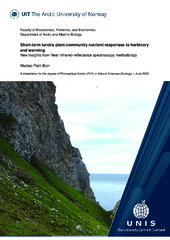Blar i forfatter "Petit Bon, Matteo"
-
Forage quality in tundra grasslands under herbivory: Silicon-based defences, nutrients and their ratios in grasses
Petit Bon, Matteo; Inga, Katarina Gunnarsdotter; Utsi, Tove Aagnes; Jonsdottir, Ingibjørg; Bråthen, Kari Anne (Journal article; Tidsskriftartikkel; Peer reviewed, 2021-10-08)1. Herbivore-induced changes in both leaf silicon-based defence and nutrient levels are potential mechanisms through which grazers alter the quality of their own grass supply. In tundra grasslands, herbivores have been shown to increase nutrient contents of grasses; yet, it is an open question whether they also increase grass silicon-based defence levels. Here, we asked if, and to what extent, ... -
Global maps of soil temperature
Lembrechts, Jonas J.; van den Hoogen, Johan; Aalto, Juha; Ashcroft, Michael B.; De Frenne, Pieter; Kemppinen, Julia; Kopecký, Martin; Luoto, Miska; Maclean, Ilya M. D.; Crowther, Thomas W.; Bailey, Joseph J.; Haesen, Stef; Klinges, David H.; Niittynen, Pekka; Scheffers, Brett R.; Van Meerbeek, Koenraad; Aartsma, Peter; Abdalaze, Otar; Abedi, Mehdi; Aerts, Rien; Ahmadian, Negar; Ahrends, Antje; Alatalo, Juha M.; Alexander, Jake M.; Altman, Jan; Allonsius, Camille Nina; Ammann, Christof; Andres, Christian; Andrews, Christopher; Ardö, Jonas; Arriga, Nicola; Arzac, Alberto; Aschero, Valeria; Leandro de Assis, Rafael; Bjerke, Jarle W.; Cooper, Elisabeth J.; Graae, Bente Jessen; Rechsteiner, Aud Helen Halbritter; Haugum, Siri Vatsø; Lang, Simone; Lynn, Joshua Scott; Moriana Armendariz, Mikel; Petit Bon, Matteo; Smith, Stuart; Sørensen, Mia Vedel; Speed, James David Mervyn; Vandvik, Vigdis; Wedegärtner, Ronja Elisabeth Magdalene; Nijs, Ivan; Lenoir, Jonathan (Journal article; Tidsskriftartikkel; Peer reviewed, 2021-12-29)Research in global change ecology relies heavily on global climatic grids derived from estimates of air temperature in open areas at around 2 m above the ground. These climatic grids do not reflect conditions below vegetation canopies and near the ground surface, where critical ecosystem functions occur and most terrestrial species reside. Here, we provide global maps of soil temperature and bioclimatic ... -
Herbivory and warming have opposing short-term effects on plant-community nutrient levels across high-Arctic tundra habitats
Petit Bon, Matteo; Bråthen, Kari Anne; Ravolainen, Virve; Ottaviani, Gianluigi; Böhner, Hanna; Jonsdottir, Ingibjørg (Journal article; Tidsskriftartikkel; Peer reviewed, 2023-05-11)Environmental changes can rapidly alter standing biomass in tundra plant communities; yet, to what extent can they modify plant-community nutrient levels? Nutrient levels and their changes can affect biomass production, nutrient cycling rates and nutrient availability to herbivores. We examined how environmental perturbations alter Arctic plant-community leaf nutrient concentrations (percentage of ... -
Interactions between winter and summer herbivory affect spatial and temporal plant nutrient dynamics in tundra grassland communities
Petit Bon, Matteo; Inga, Katarina Gunnarsdotter; Jónsdóttir, Ingibjörg Svala; Utsi, Tove Aagnes; Soininen, Eeva Marjatta; Bråthen, Kari Anne (Journal article; Tidsskriftartikkel; Peer reviewed, 2020-04-27)In the long‐term, herbivores can alter nutrient dynamics in terrestrial ecosystems by changing the functional composition of plant communities. Here, we ask to what extent herbivores can affect plant‐community nutrient dynamics in the short‐term. We provide theoretical expectations for immediate effects of herbivores on tundra‐grassland plant‐community nutrient levels throughout a single growing ... -
Long-term herbivore removal experiments reveal how geese and reindeer shape vegetation and ecosystem CO2-fluxes in high-Arctic tundra
Petit Bon, Matteo; Hansen, Brage Bremset; Loonen, M. J. J. E; Petraglia, Alessandro; Bråthen, Kari Anne; Böhner, Hanna; Layton-Matthews, Kate; Beard, Karen H.; Le Moullec, Mathilde; Jonsdottir, Ingibjorg Svala; Van der Wal, René (Journal article; Tidsskriftartikkel; Peer reviewed, 2023-09-23)1. Given the current rates of climate change, with associated shifts in herbivore population densities, understanding the role of different herbivores in ecosystem functioning is critical for predicting ecosystem responses. Here, we examined how migratory geese and resident, non-migratory reindeer—two dominating yet functionally contrasting herbivores—control vegetation and ecosystem processes in ... -
One leaf for all: Chemical traits of single leaves measured at the leaf surface using near-infrared reflectance spectroscopy
Petit Bon, Matteo; Böhner, Hanna; Kaino, Sissel; Moe, Torunn; Bråthen, Kari Anne (Journal article; Tidsskriftartikkel; Peer reviewed, 2020-06-10)1. The leaf is an essential unit for measures of plant ecological traits. Yet, measures of plant chemical traits are often achieved by merging several leaves, masking potential foliar variation within and among plant individuals. This is also the case with cost‐effective measures derived using near‐infrared reflectance spectroscopy (NIRS). The calibration models developed for converting NIRS spectral ... -
Short-term tundra plant-community nutrient responses to herbivory and warming: New insights from Near infrared-reflectance spectroscopy methodology
Petit Bon, Matteo (Doctoral thesis; Doktorgradsavhandling, 2020-09-22)In the long-term, herbivores and climate warming have been shown to alter nutrient levels in tundra plant communities by changing the functional composition of the vegetation. Here, I asked the extent to which they affect tundra plant-community nutrient levels in the short-term by directly modifying the chemistry of plants. I first developed a time- and cost-effective method that allowed me to ... -
Stomping in silence: Conceptualizing trampling effects on soils in polar tundra
Tuomi, Maria; Väisänen, Maria; Ylänne, H; Brearley, Francis Q.; Barrio, Isabel C.; Bråthen, Kari Anne; Eischeid, Isabell; Forbes, Bruce C.; Jónsdóttir, Ingibjörg; Kolstad, Anders Lorentzen; Macek, Petr; Petit Bon, Matteo; Speed, James David Mervyn; Stark, Sari; Svavarsdóttir, Kristin; Thorsson, Johann; Bueno, C. Guillermo (Journal article; Tidsskriftartikkel; Peer reviewed, 2020-11-24)<ol> <li>Ungulate trampling modifies soils and interlinked ecosystem functions across biomes. Until today, most research has focused on temperate ecosystems and mineral soils while trampling effects on cold and organic matter‐rich tundra soils remain largely unknown.</li><p> <p><li>We aimed to develop a general model of trampling effects on soil structure, biota, microclimate and biogeochemical ... -
Variable responses of carbon and nitrogen contents in vegetation and soil to herbivory and warming in high-Arctic tundra
Petit Bon, Matteo; Bøhner, Hanna; Bråthen, Kari Anne; Ravolainen, Virve; Jónsdóttir, Ingibjörg Svala (Journal article; Tidsskriftartikkel; Peer reviewed, 2021-09-21)Chemical responses of tundra vegetation and tundra soil to environmental changes are likely to differ, with implications for ecosystem functioning, yet they are rarely compared. Here, we aimed at comparing sensitivity and magnitude of short-term carbon and nitrogen responses of three main tundra ecosystem compartments: vascular plants, mosses, and soil, to two environmental perturbations: herbivore ...


 English
English norsk
norsk







